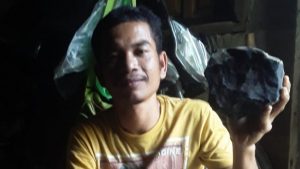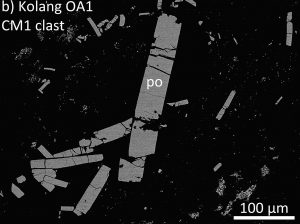Classification of the Kolang Meteorite
The afternoon of August 1, 2020, residents of Sumatra's Central Tapanuli Regency heard loud booming sounds that shook their houses. A single stone weighing over 2 kg (~4.5 lb) went through the roof of a house in the town of Kolang, embedding itself in the soil beside the house. A second stone fell in a rice paddy approximately 2 km away, and two more stones (both ~100 g) were found approximately 8 km away.

MB 109: The interiors of the stones are dark gray to black and sparsely decorated with light-colored speckles, and host common breccia fragments that protrude from the fracture surfaces. One fragment shows a large (3 mm) CAI with a pinkish hue. Three breccia types are visible: hard with conchoidal fracture and lacking or poor in chondrules; chondrule rich; and, greenish gray. Powder XRD shows considerable mineralogical diversity between different areas of matrix and clasts. Representative pieces from the bulk matrix are dominated by serpentine, with medium- to low-intensity reflections for regularly interstratified tochilinite/cronstedtite, tochilinite, calcite, pyrrhotite, and pentlandite. Some areas contain two distinct serpentines with basal spacings of 7.297 and 7.213 Å. BSE images from an ~1.5 × 2 cm fragment from the visually average lithology shows intense brecciation at all magnification scales, but is best described by two end-member petrographies. A) Intensely comminuted consisting of breccia fragments, sparse silicate fragments, and rare recognizable chondrules in a fine-grained matrix that is locally PCP rich. The chondrules and silicate fragments show a range of alteration to hydrous phases and many lack anhydrous silicates. B) Chondrule-rich breccia clast with a matrix dominated by PCP-rich objects. Chondrule mean diameter=125 μm (n=41, range 34 to 291 μm), not including a large 1.5 × 1 mm BO chondrule. Particularly noticeable in hand specimen are sparsely distributed greenish-gray breccia clasts (to 2 cm). Powder XRD shows the clast to be dominated by two serpentines, pyrrhotite, pentlandite, and calcite, and a medium-intensity basal reflection from well-crystallized smectite. Polished mount of this clast shows abundant chondrule pseudomorphs and coarse-grained sulfides.[/expand]
The main mass is blocky with a flat face and well-developed regmaglypts, and reveals a highly brecciated interior. Fragments crushed with water emit a delicate, earthy smell, though not as persistent or complex as that from Aguas Zarcas or Murchison.
"Kolang is one of the weirdest stones we have", says Garvie. "Part of the difficulty working on it is that it's super brecciated; two pieces can be completely different."
The stone's petrography, oxygen isotope ratios, and olivine compositional range fall within the CM (Mighei group chondrites):
All the oxygen isotopes, except the metal- and chondrule-rich clast, fall within the CM field. The dominant lithology contains areas with chondrules completely replaced by hydrous silicates and intimately associated and mixed with chondrules and olivine fragments partially replaced by hydrous phases (CM1/2), to areas more typical of CM2 meteorites. The bulk mineralogy is largely consistent with CM1 to 2 meteorites

A total of four stones weighing ~ 2550 g (5.6 lb) were recovered; the 2100 g main mass, the ~250 g stone from the rice paddy, a ~100 g (in two pieces), and a ~100 g complete stone (the latter 2 masses were inferred from photos).
Click here to read about Center for Meteorite Studies research on the Kolang meteorite!